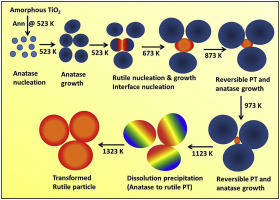当前位置:
X-MOL 学术
›
Acta Mater.
›
论文详情
Our official English website, www.x-mol.net, welcomes your
feedback! (Note: you will need to create a separate account there.)
Reversible phase transformation phenomenon in titanium dioxide films: evidence beyond interface-nucleation and dissolution-precipitation kinetics
Acta Materialia ( IF 8.3 ) Pub Date : 2018-03-01 , DOI: 10.1016/j.actamat.2017.12.050 Subodh K. Gautam , Jitendra Singh , D.K. Shukla , E. Pippel , P. Poddar , Fouran Singh
Acta Materialia ( IF 8.3 ) Pub Date : 2018-03-01 , DOI: 10.1016/j.actamat.2017.12.050 Subodh K. Gautam , Jitendra Singh , D.K. Shukla , E. Pippel , P. Poddar , Fouran Singh

|
Abstract The re-crystallization kinetics and rutile to anatase reversible phase transformation (PT) in nano-crystalline titanium dioxide (TiO2) are reported. Initially, an amorphous TiO2 film is used for the present study and in situ isothermal annealing dependent nucleation and growth kinetics of anatase and rutile phase is studied at low temperature (∼523 K) and well explained using Johnson–Mehl–Avrami-Kolmogorov (JMAK) model. The anatase nanocrystallite (NCs) transformation into rutile phase is reported with isothermal annealing for longer time and temperature dependent annealing in lower temperature range 523 K–673 K and explained using interface-nucleation mechanism. Furthermore, the thermodynamic stability of rutile NCs and lattice stress-induced reversible PT in nano-sized rutile TiO2 are confirmed in moderate temperature range (623 K - 973 K) and well explained using x-ray diffraction, micro-Raman spectroscopy and near edge x-ray absorption fine structure spectroscopy studies. However, annealing at higher temperature (1123 K - 1323 K) induces the growth of anatase NCs and their natural transform into rutile phase are explained by well-known dissolution–precipitation mechanism. Activation energy of rutile PT is quantified and found higher for dissolution-precipitation mechanism than that for interface nucleation at earlier stage. Thus, overall PT kinetics at different temperature range is well understood by invoking in three step mechanism: I) early stage anatase-to-rutile transformation is dominated by interface-nucleation, II) then intermediate stage reversible rutile-to-anatase PT and, III) at later stages, anatase-to-rutile PT is controlled by dissolution–precipitation mechanism.
中文翻译:

二氧化钛薄膜中的可逆相变现象:超越界面成核和溶解沉淀动力学的证据
摘要 报道了纳米晶二氧化钛 (TiO2) 中的重结晶动力学和金红石到锐钛矿可逆相变 (PT)。最初,本研究使用无定形 TiO2 薄膜,并在低温(~523 K)下研究了锐钛矿和金红石相的原位等温退火相关成核和生长动力学,并使用 Johnson-Mehl-Avrami-Kolmogorov (JMAK) 进行了很好的解释) 模型。据报道,锐钛矿纳米微晶 (NCs) 转变为金红石相,在较低温度范围 523 K-673 K 下进行更长的等温退火和温度依赖性退火,并使用界面成核机制进行解释。此外,金红石 NCs 的热力学稳定性和纳米金红石 TiO2 中晶格应力诱导的可逆 PT 在中等温度范围 (623 K - 973 K) 中得到证实,并使用 x 射线衍射、显微拉曼光谱和近边缘 x- 得到了很好的解释射线吸收精细结构光谱研究。然而,在较高温度 (1123 K - 1323 K) 下退火会诱导锐钛矿 NCs 的生长,并且它们向金红石相的自然转变可以通过众所周知的溶解-沉淀机制来解释。金红石 PT 的活化能被量化,发现溶解-沉淀机制的活化能高于早期界面成核的活化能。因此,通过调用三步机制可以很好地理解不同温度范围内的整体 PT 动力学:
更新日期:2018-03-01
中文翻译:

二氧化钛薄膜中的可逆相变现象:超越界面成核和溶解沉淀动力学的证据
摘要 报道了纳米晶二氧化钛 (TiO2) 中的重结晶动力学和金红石到锐钛矿可逆相变 (PT)。最初,本研究使用无定形 TiO2 薄膜,并在低温(~523 K)下研究了锐钛矿和金红石相的原位等温退火相关成核和生长动力学,并使用 Johnson-Mehl-Avrami-Kolmogorov (JMAK) 进行了很好的解释) 模型。据报道,锐钛矿纳米微晶 (NCs) 转变为金红石相,在较低温度范围 523 K-673 K 下进行更长的等温退火和温度依赖性退火,并使用界面成核机制进行解释。此外,金红石 NCs 的热力学稳定性和纳米金红石 TiO2 中晶格应力诱导的可逆 PT 在中等温度范围 (623 K - 973 K) 中得到证实,并使用 x 射线衍射、显微拉曼光谱和近边缘 x- 得到了很好的解释射线吸收精细结构光谱研究。然而,在较高温度 (1123 K - 1323 K) 下退火会诱导锐钛矿 NCs 的生长,并且它们向金红石相的自然转变可以通过众所周知的溶解-沉淀机制来解释。金红石 PT 的活化能被量化,发现溶解-沉淀机制的活化能高于早期界面成核的活化能。因此,通过调用三步机制可以很好地理解不同温度范围内的整体 PT 动力学:











































 京公网安备 11010802027423号
京公网安备 11010802027423号